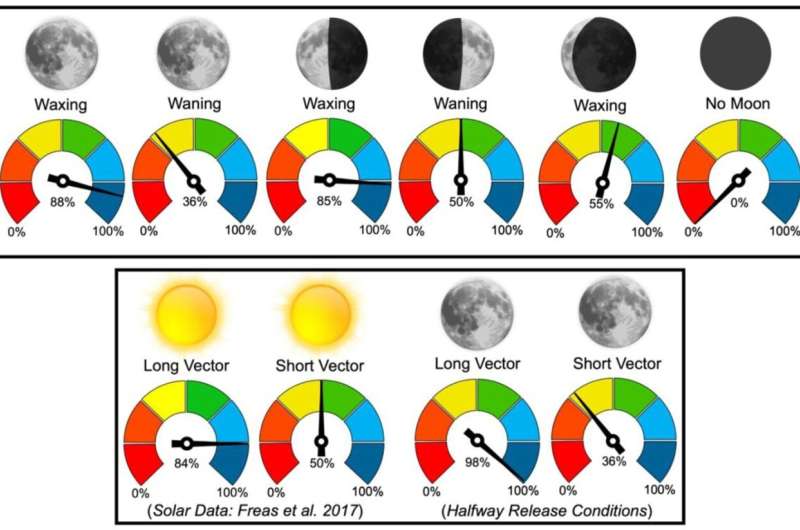This article has been reviewed according to Science X's editorial process and policies. Editors have highlighted the following attributes while ensuring the content's credibility:
fact-checked
peer-reviewed publication
trusted source
proofread
Ants detect and monitor low levels of moonlight to navigate at night, new study shows

Nocturnal bull ants can use low-level moonlight to navigate at night, according to new research.
The study, published today as a Reviewed Preprint in eLife, is described by the editors as important work that substantially advances our understanding of nocturnal animal navigation and the ways that animals use polarized light. The evidence supporting the conclusions is convincing, and the work will be of interest to biologists working on animal navigation or sensory ecology.
Many animals use the position of the sun or moon to guide their movement. But because these celestial bodies are often obscured by clouds or forest canopy, they must rely on detecting patterns of polarized skylight, also known as e-vectors—the by-product of light passing through the upper atmosphere. They do this by detecting light cues through specialized photoreceptors in their eyes, and combine this information with terrestrial cues from their surrounding environment to adapt their navigation strategy (known as their path integrator).
"Like solar polarization, though a million times weaker, the moon reflects sunlight and produces a polarized moonlight pattern determined by its position in the sky," explains lead author Cody Freas, research fellow in the School of Natural Sciences, Macquarie University, Sydney, Australia.
"Given that the moon is much dimmer, it's thought that only night-navigating insects with eyes specialized for low light detection can rely on this pattern. Nocturnal dung beetles are one example, but because ants can use the moon's position as a compass, we set out to study whether they can also detect lower levels of polarized moonlight patterns at night."
The researchers studied two nests of nocturnal bull ants (Myrmecia midas) over a seven-month period, located on the Macquarie University Wallumattagal campus in Sydney, Australia. Bull ants tend to start foraging within 20 minutes of sunset, traveling from the nest and up nearby eucalyptus trees. Their return to the nest is more variable, with some foragers returning overnight and others doing so during morning twilight.
The team conducted these tests across the lunar cycle—from nights with new, full, crescent and quarter moons—including when the moon was waxing (when the moon rises before sunset and sets overnight) and waning—when the moon rises overnight and leaves a gap in polarized light cues after the sun has set.
For each of these conditions, the researchers altered the pattern of polarized moonlight by rotating a filter, which changes the direction of the dominant e-vector. Across all conditions, they recorded the ant's release point, position when the filter was applied, the position when the filter was removed and their reorientation one meter after they left the filter.
They found that bull ant foragers altered the direction they were heading, in a predictable way, in response to the changing rotations of overhead lunar light polarization. This behavior was consistent regardless of the stage in the lunar cycle, even under a crescent moon with only 20% illumination. This suggests that polarized moonlight is detectable by the ants across the lunar month, making it a stable cue they can use when moving or updating their path integrator.
One surprising finding was the observation that foragers reduced their changes in direction when the moon was waning, suggesting that the moon's absence for a portion of the night leads to a gap in navigational cues. This difference also suggests that the ants continuously track moonlight polarization, in line with this celestial cue being an important aspect of their navigational strategy. Moreover, these changes are similar to how the bull ant adapts to changes in solar light polarization, suggesting the same visual pathways are used.
"This is the first evidence of foraging ants using polarized moonlight to navigate to a goal location, and suggests that polarized moonlight is detectable by these insects throughout the lunar month," concludes senior author Ken Cheng, a Professor in the School of Natural Sciences, Macquarie University.
"Our findings suggest that polarized moonlight is detected and integrated into the ant's path integrator along the same visual pathways as polarized sunlight, and that these animals can weight the information provided, thus tailoring their navigational decisions to closely match the reliability of available navigational information."
"This represents a navigational system that can use the same underlying neural circuitry to navigate at both day and night with no mechanistic alterations, switching between solar and lunar polarization for compass cues," adds Freas. "Thus, a polarization pattern-based sky compass becomes a useful 'all hours' directional compass with only visual light sensitivity needed to make solar navigation-based tools work at night."
More information: Cody A Freas et al, Polarised Moonlight Guides Nocturnal Bull Ants Home, eLife (2024). DOI: 10.7554/eLife.97615.1
Journal information: Royal Society Open Science , eLife
Provided by eLife



















